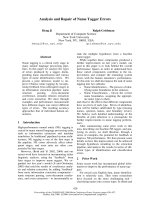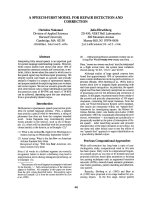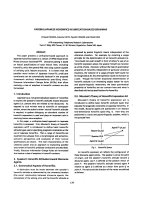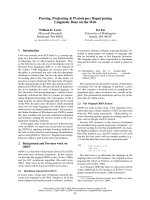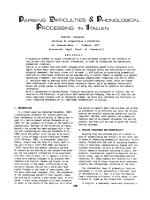Báo cáo khoa học: "Parsing Speech Repair without Specialized Grammar Symbols∗" ppt
Bạn đang xem bản rút gọn của tài liệu. Xem và tải ngay bản đầy đủ của tài liệu tại đây (119.28 KB, 4 trang )
Proceedings of the ACL-IJCNLP 2009 Conference Short Papers, pages 277–280,
Suntec, Singapore, 4 August 2009.
c
2009 ACL and AFNLP
Parsing Speech Repair without Specialized Grammar Symbols
∗
Tim Miller
University of Minnesota
Luan Nguyen
University of Minnesota
William Schuler
University of Minnesota
Abstract
This paper describes a parsing model for
speech with repairs that makes a clear sep-
aration between linguistically meaningful
symbols in the grammar and operations
specific to speech repair in the operation of
the parser. This system builds a model of
how unfinished constituents in speech re-
pairs are likely to finish, and finishes them
probabilistically with placeholder struc-
ture. These modified repair constituents
and the restarted replacement constituent
are then recognized together in the same
way that two coordinated phrases of the
same type are recognized.
1 Introduction
Speech repair is a phenomenon in spontaneous
spoken language in which a speaker decides to
interrupt the flow of speech, replace some of the
utterance (the “reparandum”), and continues on
(with the “alteration”) in a way that makes the
whole sentence as transcribed grammatical only
if the reparandum is ignored. As Ferreira et al.
(2004) note, speech repairs
1
are the most disrup-
tive type of disfluency, as they seem to require
that a listener first incrementally build up syntac-
tic and semantic structure, then subsequently re-
move it and rebuild when the repair is made. This
difficulty combines with their frequent occurrence
to make speech repair a pressing problem for ma-
chine recognition of spontaneous speech.
This paper introduces a model for dealing with
one part of this problem, constructing a syntac-
tic analysis based on a transcript of spontaneous
spoken language. The model introduced here dif-
fers from other models attempting to solve the
∗
This research was supported by NSF CAREER award
0447685. The views expressed are not necessarily endorsed
by the sponsors .
1
Ferreira et al. use the term ‘revisions’.
same problem, by completely separating the fluent
grammar from the operations of the parser. The
grammar thus has no representation of disfluency
or speech repair, such as the “EDITED” category
used to represent a reparandum in the Switchboard
corpus, as such categories are seemingly at odds
with the typical nature of a linguistic constituent.
Rather, the approach pres ented here uses a
grammar that explicitly represents incomplete
constituents being processed, and repair is rep-
resented by r ules which allow incomplete con-
stituents to be prematurely merged with existing
structure. While this model is interesting for its
elegance in representation, there is also reason
to hypothesize improved performance, since this
processing model requires no additional grammar
symbols, and only one additional operation to ac-
count for speech repair, and thus makes better use
of limited data resources.
2 Background
Previous work on parsing of speech with repairs
has shown that syntactic cues can be used to in-
crease accuracy of detection of reparanda, which
can increase overall parsing accuracy. The first
source of structure used to recognize repair is what
Levelt (1983) called the “Well-formedness Rule.”
This rule essentially states that a speech repair acts
like a conjunction; that is, the reparandum and the
alteration must be of the same syntactic category.
Of course, the reparandum is often unfinished, so
the Well-formedness Rule allows for the reparan-
dum category to be inferred.
This source of structure has been used by two
related approaches, that of Hale et al. (2006) and
Miller (2009). Hale and colleagues exploit this
structure by adding contextual information to the
standard reparandum label “EDITED”. In their
terminology, daughter annotation takes the (pos-
sibly unfinished) constituent label of the reparan-
dum and appends it to the EDITED label. This
277
allows a learned probabilistic context-free gram-
mar to represent the likelihood of a reparandum of
a certain type being a sibling with a finished con-
stituent of the same type.
Miller’s approach exploited the same source of
structure, but changed the representation to use
a REPAIRED label for alterations instead of an
EDITED label for reparanda. The rationale for
that change is the fact that a speech repair does not
really begin until the interruption point, at which
point the alteration is started and the reparandum
is retroactively labelled as such. Thus, the argu-
ment goes, no special syntactic rules or symbols
should be necessary until the alteration begins.
3 Model Description
3.1 Right-corner transform
This work first uses a right-corner transform,
which turns right-branching structure into left-
branching structure, using category labels that use
a “slash” notation α/γ to represent an incomplete
constituent of type α “looking for” a constituent
of type γ in order to complete itself.
This transform first requires that trees be bina-
rized. This binarization is done in a similar way to
Johnson (1998) and Klein and Manning (2003).
Rewrite rules for the right-corner transform are
as follows, first flattening right-branching struc-
ture:
2
A
1
α
1
A
2
α
2
A
3
a
3
⇒
A
1
A
1
/A
2
α
1
A
2
/A
3
α
2
A
3
a
3
A
1
α
1
A
2
A
2
/A
3
α
2
. . .
⇒
A
1
A
1
/A
2
α
1
A
2
/A
3
α
2
. . .
then replacing it with left-branching structure:
A
1
A
1
/A
2
:α
1
A
2
/A
3
α
2
α
3
. . .
⇒
A
1
A
1
/A
3
A
1
/ A
2
:α
1
α
2
α
3
. . .
One problem with this notation is the represen-
tation given to unfinished constituents, as seen in
Figures 1 and 2. The standard representation of
2
Here, all A
i
denote nonterminal symbols, and α
i
denote
subtrees; the notation A
1
:α
0
indicates a subtree α
0
with label
A
1
; and all rewrites are applied recursively, from leaves to
root.
S
.
EDITED
PP
IN
as
NP-UNF
DT
a
PP
IN
as
NP
NP
DT
a
NN
westerner
PP-LOC
IN
in
NP
NNP
india
.
Figure 1: Section of interest of a standard phrase
structure tree containing speech repair with unfin-
ished noun phrase (NP).
PP
PP/NP
PP/PP
PP/NP
PP/PP
EDITEDPP
EDITEDPP/NP-UNF
IN
as
NP-UNF
DT
a
IN
as
NP
NP/NN
DT
a
NN
westerner
IN
in
NP
india
Figure 2: Right-corner transformed version of the
fragment above. This tree requires several special
symbols to represent the reparandum that starts
this fragment.
an unfinished constituent in the Switchboard cor-
pus is to append the -UNF label to the lowest un-
finished constituent (see Figure 1). Since one goal
of this work is separation of linguistic knowledge
from language processing mechanisms, the -UNF
tag should not be an explicit part of the gram-
mar. In theory, the incomplete category notation
induced by the right-corner transform is perfectly
suited to this purpose. For instance, the category
NP-UNF is a stand in category for several incom-
plete constituents, for example NP/NN, NP/NNS,
etc. However, since the sub-trees with -UNF la-
bels in the original corpus are by definition unfin-
ished, the label to the right of the slash (NN in
this case) is not defined. As a result, transformed
trees with unfinished structure have the represen-
tation of Figure 2, which gives away the positive
benefits of the right-corner transform in r epresent-
ing repair by propagating a special repair symbol
(EDITED) through the grammar.
3.2 Approximating unfinished constituents
It is possible to represent -UNF categories as stan-
dard unfinished cons tituents, and account for un-
finished constituents by having the parser prema-
278
turely end the processing of a given constituent.
However, in the example given above, this would
require predicting ahead of time that the NP-UNF
was only missing a common noun – NN (for ex-
ample). This problem is addressed in this work
by probabilistically filling in placeholder final cat-
egories of unfinished constituents in the standard
phrase structure trees, before applying the right-
corner transform.
In order to fill in the placeholder with realistic
items, phrase completions are learned from cor-
pus statistics. First, this algorithm identifies an
unfinished constituent to be finished as well as its
existing children (in the continuing example, NP-
UNF with child labelled DT). Next, the corpus is
searched for fluent subtrees with matching root la-
bels and child labels (NP and DT), and a distri-
bution is computed of the actual completions of
those subtrees. In the model used in this work,
the most common completions are NN, NNS, and
NNP. The original NP-UNF subtree is then given a
placeholder completion by sampling from the dis-
tribution of completions computed above.
After this addition is complete, the UNF and
EDITED labels are removed from the reparandum
subtree, and if a restarted constituent of the same
type is a sibling of the reparandum (e.g. another
NP), the two subtrees are made siblings under a
new subtree with the same category label (NP).
See Figure 3 for a simple visual example of how
this works.
S
. EDITED
PP
IN
as
NP
DT
a
NN
eli
PP
IN
as
NP
NP
DT
a
NN
westerner
PP-LOC
IN
in
NP
NNP
india
.
Figure 3: Same tree as in Figure 1, with the un-
finished noun phrase now given a placeholder NN
completion (both bolded).
Next, these trees are modified using the right-
corner transform as shown in Figure 4. This tree
still contains placeholder words that will not be
in the text stream of an observed input sentence.
Thus, in the final step of the preprocessing algo-
rithm, the finished category label and the place-
holder right child are removed where found in a
right-corner tree. This results in a right-corner
transformed tree in which a unary child or right
PP
PP/NNP
PP/PP
PP/NP
PP/PP
PP
PP/NN
PP/NP
IN
as
DT
a
NN
eli
IN
as
NP
NP/NN
DT
a
NN
westerner
IN
in
NNP
india
Figure 4: Right-corner transformed tree with
placeholder finished phrase.
PP
PP/NNP
PP/PP
PP/NP
PP/PP
PP/NN
PP/NP
IN
as
DT
a
IN
as
NP
NP/NN
DT
a
NN
westerner
IN
in
NNP
india
Figure 5: Final right-corner transformed state af-
ter excising placeholder completions to unfinished
constituents. The bolded label indicates the signal
of an unfinished category reparandum.
child subtree having an unfinished constituent type
(a slash category, e.g. PP/NN in Figure 5) at its
root represents a reparandum with an unfinished
category. The tree then represents and processes
the rest of the repair in the same way as a coordi-
nation.
4 Evaluation
This model was evaluated on the Switchboard cor-
pus (Godfrey et al., 1992) of conversational tele-
phone speech between two human interlocuters.
The input to this system is the gold standard
word transcriptions, segmented into individual ut-
terances. For comparison to other similar systems,
the system was given the gold standard part of
speech for each input word as well. The standard
train/test breakdown was used, with sections 2 and
3 used for training, and subsections 0 and 1 of sec-
tion 4 used for testing. Several sentences from the
end of section 4 were used during development.
For training, the data set was first standardized
by removing punctuation, empty categories, ty-
pos, all categories representing repair structure,
279
and partial words – anything that would be diffi-
cult or impossible to obtain reliably with a speech
recognizer.
The two metrics used here are the standard Par-
seval F-measure, and Edit-finding F. The first takes
the F-score of labeled precision and recall of the
non-terminals in a hypothesized tree relative to the
gold standard tree. The second measure marks
words in the gold standard as edited if they are
dominated by a node labeled EDITED, and mea-
sures the F-score of the hypothesized edited words
relative to the gold standard.
System Configuration Parseval-F Edited-F
Baseline CYK 71.05 18.03
Hale et al. 68.48 37.94
Plain RC Trees 69.07 30.89
Elided RC Trees 67.91 24.80
Merged RC Trees 68.88 27.63
Table 1: Results
Results of the testing can be seen in Ta-
ble 1. The first line (“Baseline CYK”) indi-
cates the results using a standard probabilistic
CYK parser, trained on the standardized input
trees. The following two lines are results from re-
implementations of the systems from Hale et al.
(2006) and Miller (2009). The line marked ‘Elided
trees’ gives current results. Surprisingly, this re-
sult proves to be lower than the previous results.
Two observations in the output of the parser on
the development set gave hints as to the reasons
for this performance loss.
First, repairs using the slash categories (for un-
finished reparanda) were rare (relative to finished
reparanda). This led to the suspicion that there
was a state-splitting phenomenon, where cate-
gories previously lumped together as EDITED-NP
were divided into several unfinished categories
(NP/NN, NP/NNS, etc.). To test this suspicion, an-
other experiment was performed where all unary
child and right child subtrees with unfinished cat-
egory labels X/Y were replaced with EDITED-X.
This result is shown in line five of Table 1. This
result improves on the elided version, and sug-
gests that the state-splitting effect is most likely
one cause of decreased performance.
The second effect in the parser output was the
presence of several very long reparanda (more
than ten words), which are highly unlikely in nor-
mal speech. This phenomenon does not occur
in the ‘Plain RC Trees’ condition. One explana-
tion f or this effect is that plain RC trees use the
EDITED label in each rule of the reparandum (see
Figure 2 for a s hort real-world example). This
essentially creates a reparandum rule set, mak-
ing expansion of a reparandum difficult due to the
likelihood of a long chain eventually requiring a
reparandum rule that was not found in the train-
ing data, or was not learned correctly in the much
smaller set of reparandum-specific training data.
5 Conclusion and Future Work
In conclusion, this paper has presented a new
model for speech containing repairs that enforces
a clean separation between linguistic categories
and parsing operations. Performance was below
expectations, but analysis of the interesting rea-
sons for these results suggests future directions. A
model which explicitly represents the distance that
a speaker backtracks when making a repair would
prevent the parser from hypothesizing the unlikely
reparanda of great length.
References
Fernanda Ferreira, Ellen F. Lau, and Karl G.D. Bai-
ley. 2004. Disfluencies, language comprehension,
and Tree Adjoining Grammars. Cognitive Science,
28:721–749.
John J. Godfrey, Edward C. Holliman, and Jane Mc-
Daniel. 1992. Switchboard: Telephone speech cor-
pus for research and development. In Proc. ICASSP,
pages 517–520.
John Hale, Izhak Shafran, Lisa Yung, Bonnie Dorr,
Mary Harper, Anna Krasnyanskaya, Matthew Lease,
Yang Liu, Brian Roark, Matthew Snover, and Robin
Stewart. 2006. PCFGs with syntactic and prosodic
indicators of speech repairs. In Proceedings of the
45th Annual Conference of the Association for Com-
putational Linguistics (COLING-ACL).
Mark Johnson. 1998. PCFG models of linguistic tree
representation. Computational Linguistics, 24:613–
632.
Dan Klein and Christopher D. Manning. 2003. Ac-
curate unlexicalized parsing. In Proceedings of the
41st Annual Meeting of the Association for Compu-
tational Linguistics, pages 423–430.
Willem J.M. Levelt. 1983. Monitoring and self-repair
in s peech. Cognition, 14:41–104.
Tim Miller. 2009. Improved syntactic models for pars-
ing speech with repairs. In Proceedings of the North
American Association for Computational Linguis-
tics, Boulder, CO.
280
